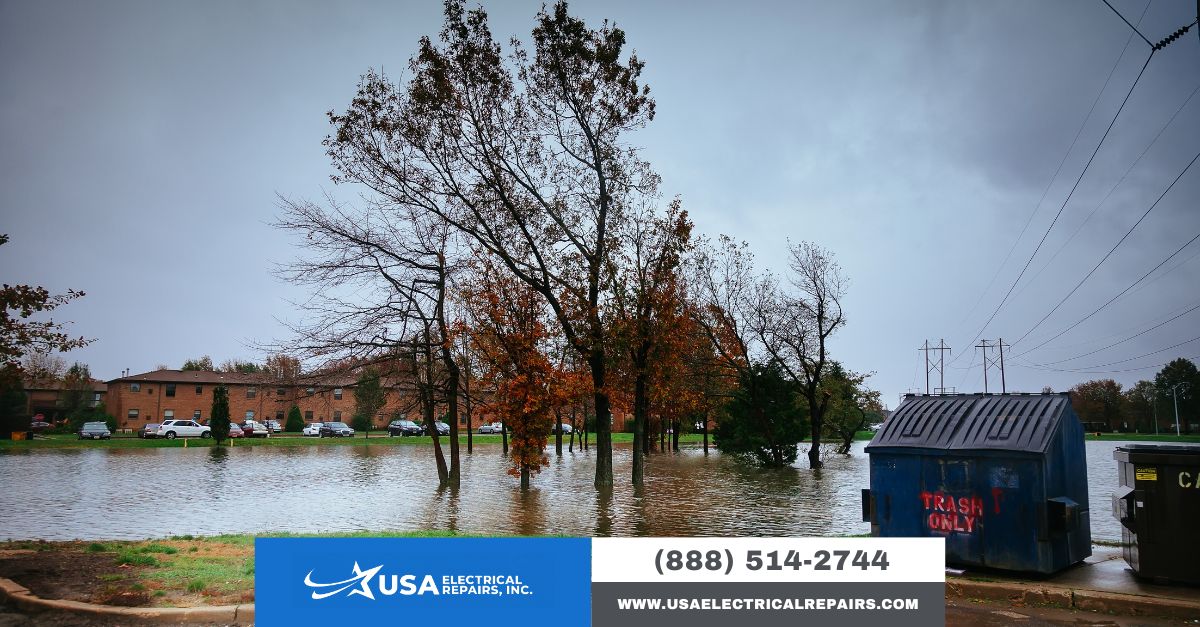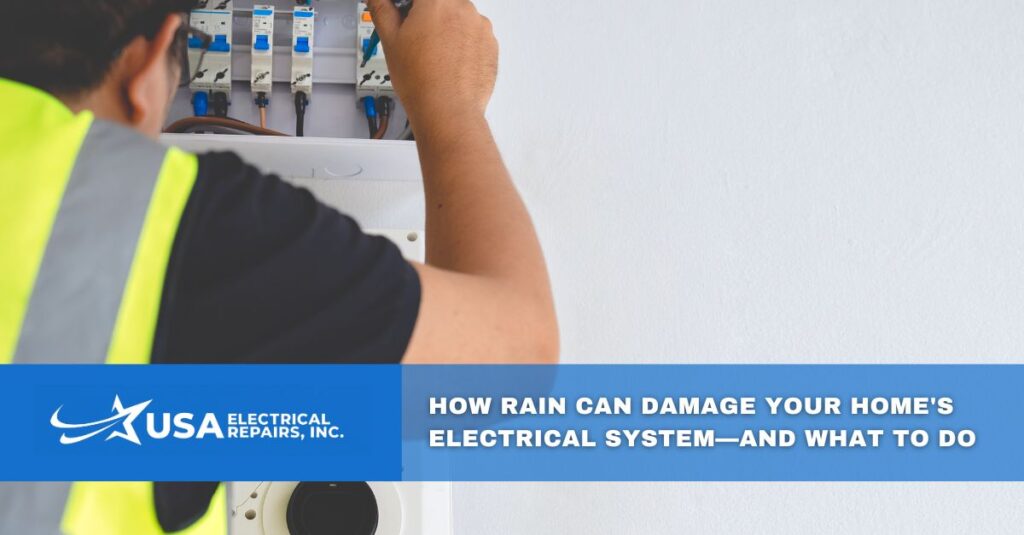Rain brings relief from hot summer days and nourishes your garden, but it can also pose serious threats to your home’s electrical system. Rain electrical damage can lead to costly repairs, safety hazards, and even life-threatening situations when water and electricity meet.
Understanding how moisture affects your electrical components helps you take proactive steps to protect your home. From subtle water intrusion that gradually corrodes wiring to sudden short circuits that can spark fires, rain electrical damage represents a real risk that requires your attention.
This guide explores the most common ways rain damages electrical systems and provides practical solutions to safeguard your home. By learning to identify warning signs and knowing when to call professionals, you can minimize rain electrical damage and protect your family.

How Moisture Infiltrates Your Electrical System and Causes Rain Electrical Damage
Water finds its way into electrical systems through various pathways, often in ways homeowners don’t expect. Understanding these entry points helps you address vulnerabilities before they become expensive problems.
Roof and Attic Penetration
Damaged shingles, clogged gutters, and deteriorated flashing create perfect entry points for rainwater. Once water penetrates your roof, it can travel along electrical conduits and drip onto junction boxes, outlets, and wiring hidden in your walls.
Attic spaces are particularly vulnerable because electrical components are often exposed or housed in basic enclosures. Water damage here can affect multiple circuits throughout your home, making early detection crucial.
Wall and Foundation Intrusion
Cracks in your home’s exterior walls or foundation allow moisture to seep inside, where it can contact electrical wiring and outlets. This type of water damage often goes unnoticed until significant problems develop.
Basement and crawl space electrical components face constant exposure to humidity and potential flooding. Poor drainage around your foundation compounds these risks, especially during heavy rainfall.
Window and Door Penetration
Improperly sealed windows and doors let rainwater infiltrate wall cavities where electrical wiring runs. This moisture can accumulate over time, creating conditions for gradual electrical system deterioration.
Weather stripping and caulk deteriorate with age, creating gaps that allow water entry. Regular maintenance of these seals protects both your home’s structure and electrical infrastructure.
Understanding Short Circuits and Electrical Hazards from Rain Electrical Damage
When water contacts electrical components, several dangerous scenarios can unfold. Recognizing these risks helps you respond appropriately and prioritize safety.
Ground Faults and GFCI Protection
Water creates unintended electrical pathways that can cause current to flow where it shouldn’t. This condition, called a ground fault, can result in electrical shock or electrocution if you touch affected fixtures or appliances.
Ground Fault Circuit Interrupter (GFCI) outlets detect these dangerous conditions and shut off power within milliseconds. However, GFCI protection only works if devices are properly installed and functioning correctly.
Arc Faults and Fire Risks
Moisture can cause electrical arcing, where electricity jumps across gaps in damaged wiring or components. These arcs generate intense heat that can ignite nearby materials, potentially starting house fires.
Arc faults are particularly dangerous because they can occur inside walls where they’re difficult to detect. Modern Arc Fault Circuit Interrupter (AFCI) breakers provide protection, but older homes may lack this safety feature.
Power Surges and Equipment Damage
Water damage can cause sudden changes in electrical resistance, leading to power surges that damage sensitive electronics and appliances. These surges can destroy expensive equipment like computers, televisions, and smart home devices.
Lightning strikes during storms compound surge risks, especially if your electrical system has water-related vulnerabilities. Proper grounding and surge protection become even more critical when moisture is present.
Protecting Outdoor Electrical Outlets from Rain Electrical Damage
Outdoor electrical components face direct exposure to rain and require special attention to prevent water-related damage.
Weatherproof Outlet Covers
Standard outlet covers provide minimal protection against driving rain and snow. Upgrading to weatherproof covers with gaskets and tight-fitting lids keeps moisture out of outlet boxes.
In-use weatherproof covers allow you to keep items plugged in while maintaining protection. These covers accommodate extension cords and device plugs without compromising water resistance.
GFCI Requirements for Outdoor Circuits
All outdoor outlets must have GFCI protection to prevent electrical shock in wet conditions. This protection can be provided by GFCI outlets, GFCI breakers, or portable GFCI devices.
Regular testing ensures GFCI devices function properly when needed. Test monthly by pressing the “test” button to trip the device, then press “reset” to restore power. If the device doesn’t trip or won’t reset, it requires immediate replacement.
Proper Installation and Maintenance
Outdoor electrical boxes need proper mounting and sealing to prevent water intrusion. Boxes should be caulked where they meet exterior surfaces, and all conduit connections should be watertight.
Inspect outdoor electrical components seasonally, looking for signs of corrosion, loose connections, or damaged covers. Address problems promptly to prevent more extensive damage.
Warning Signs of Rain Electrical Damage to Electrical Systems
Early detection of moisture-related electrical problems can prevent dangerous situations and costly repairs. Watch for these warning signs throughout your home.
Visual Indicators
Discoloration or staining around outlets, switches, or electrical panels often indicates water intrusion. Brown or black marks may signal overheating caused by moisture-related electrical problems.
Corrosion on electrical components appears as white, green, or rust-colored deposits. This oxidation process weakens connections and can lead to electrical failures or fires.
Performance Issues
Flickering lights or intermittent power loss may indicate water damage affecting electrical connections. These symptoms often worsen during or after rainstorms when moisture levels are highest.
Frequent tripping of circuit breakers or blown fuses can signal ground faults or short circuits caused by water intrusion. Don’t simply reset breakers repeatedly—investigate the underlying cause.
Unusual Smells and Sounds
Burning odors near electrical components require immediate attention and may indicate dangerous conditions. Turn off power to affected circuits and contact an electrician immediately.
Crackling, buzzing, or sizzling sounds from outlets, switches, or panels can indicate arcing caused by moisture. These sounds often signal serious safety hazards requiring professional electrical repair.
Professional Assessment and Electrical Repair Solutions for Rain Electrical Damage
While some protective measures can be implemented by homeowners, water damage to electrical systems often requires professional diagnosis and repair.
Comprehensive Electrical Inspections
Professional electricians have specialized tools to detect moisture in electrical systems, including thermal imaging cameras and moisture meters. These devices reveal problems hidden behind walls or in enclosed spaces.
Electrical inspections should include testing of GFCI and AFCI devices, examination of panel conditions, and assessment of grounding systems. Professional evaluations identify vulnerabilities before they become safety hazards.
Repair and Replacement Services
Water-damaged electrical components often require complete replacement rather than repair. Corroded wiring, deteriorated insulation, and damaged outlets can’t be safely restored to their original condition.
Professional electrical repair services ensure work meets current safety codes and installation standards. This compliance protects your family and may be required for insurance coverage or home sales.
Preventive Upgrades
Modern electrical systems include safety features that older homes may lack. Upgrading panels, installing whole-house surge protection, and adding GFCI and AFCI protection significantly improve safety and reliability.
Weatherproofing upgrades for outdoor electrical components prevent future water damage problems. Professional installation ensures proper sealing and protection against moisture intrusion.
Taking Action to Prevent Rain Electrical Damage in Your Home
Rain damage to electrical systems poses serious risks that require immediate attention and ongoing vigilance. Regular maintenance, proper protection, and professional assessment help ensure your family’s safety and your home’s reliability.
Start by inspecting your home’s electrical components for signs of moisture damage, paying special attention to outdoor outlets, basement areas, and locations near potential water sources. Address any problems promptly to prevent escalation into dangerous situations.
Don’t attempt electrical repairs yourself if you suspect water damage. The combination of electricity and moisture creates hazardous conditions that require professional expertise and specialized safety equipment.
Call USA Electrical Repairs, Inc. at 888-514-2744 to schedule your comprehensive electrical panel evaluation. Our experienced electricians will provide honest assessments and transparent pricing to help you make the best decision for your home and budget. You can also browse our website for more information about our electrical installation services and see how we’ve helped other Los Angeles homeowners solve their electrical challenges safely and effectively.

